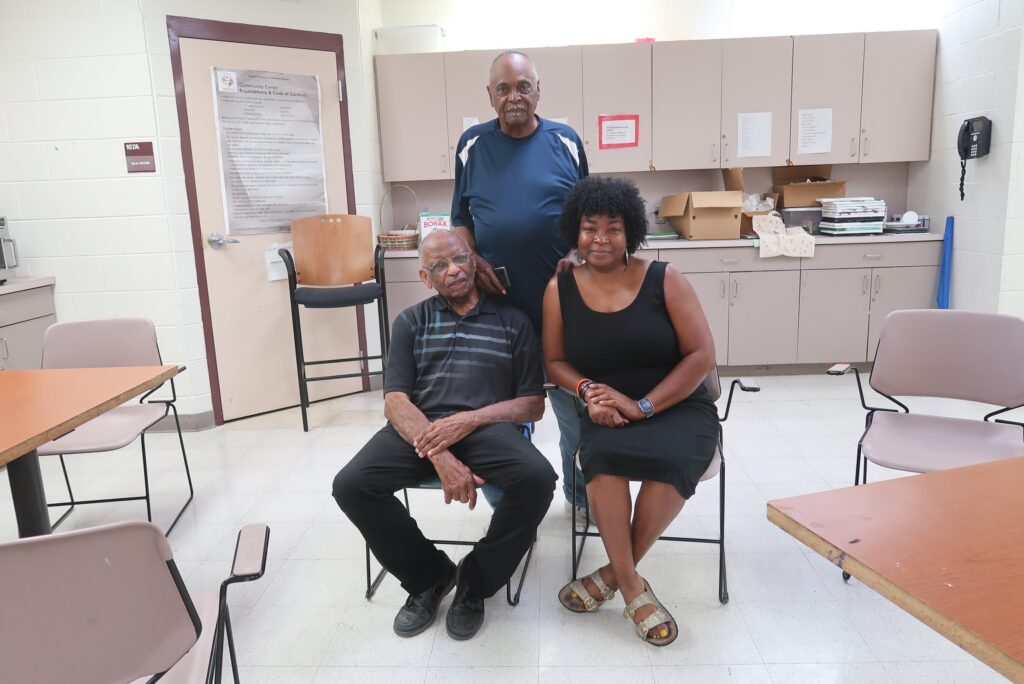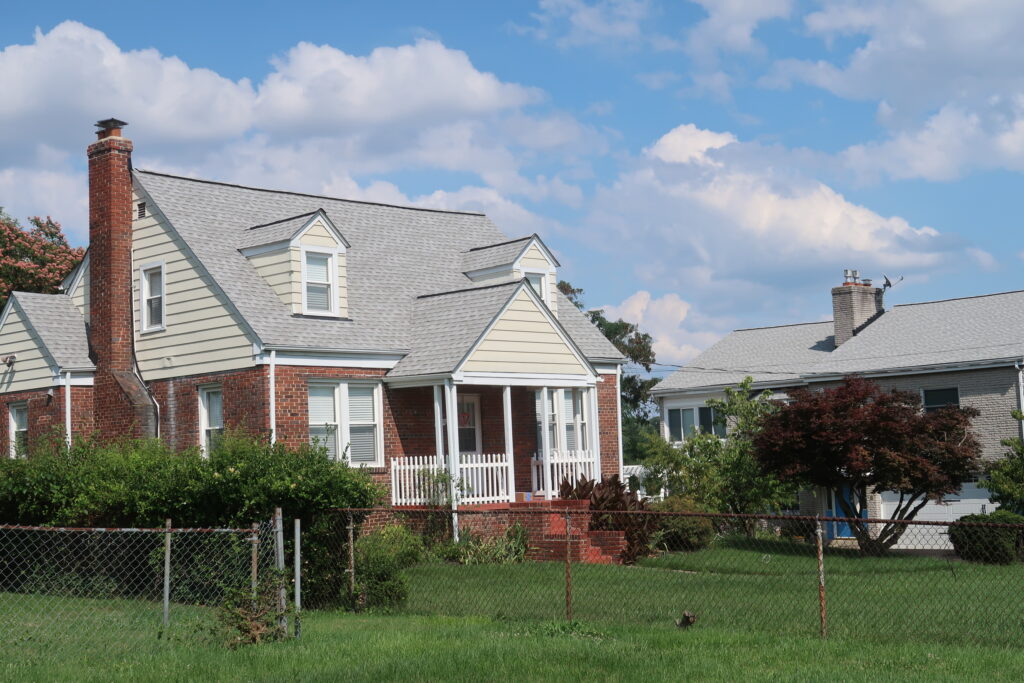A Bailey’s Xroads resident is documenting the history of a vibrant Black community

The Springdale neighborhood in Bailey’s Crossroads has long been the center of a flourishing Black community.
But now, the history of that community is in danger of being lost as younger generations have moved out, McMansions replaced many of the smaller houses, and new developments are encroaching on the neighborhood. Springdale is centered around Lacy Boulevard, Magnolia Lane, and Munson Road.
Julius Smith, who grew up in the neighborhood, is working on documenting that history for a nonprofit he founded called the Black American Registry of Bailey’s Crossroads. A celebration next Saturday, July 15, at the Bailey’s Community Center, 4-10 p.m., marks the first anniversary of that project.
Family stories
Smith is putting together genealogical records and mapping the addresses of the Black families who lived there. The community once had about 2,000 Black families, he says; now only 43 remain.
He is also interviewing the oldest residents and documenting their stories about life in Bailey’s Crossroads – the good times and the challenges during the Jim Crow era.

The Springdale community was originally settled by Blacks fleeing the South for jobs in Washington, D.C.
Many of them settled in Freedom City established during the Lincoln Administration to house federal workers. In the early 1940s, Freedom City was torn down to make way for construction of the Pentagon.
Both Julius Smith and Dwight Somers had ancestors who were displaced from Freedom City and moved to Bailey’s Crossroads.
A close-knit community
Somers, who was born in 1948, recalls growing up in a community where everyone looked out for one another. “If I got in trouble in school, by the time I got home, everyone knew what I did,” he says
People used to collect water from a spring on Munson Road in the 1950s before homes had running water. The community had outhouses until the 1960s
Somers says there was a big enough swimming hole in Holmes Run for kids to swim and swing from ropes. His grandfather had one of the first TVs – a big cabinet with a tiny screen – and everyone used to come over and watch it.
All the ladies did laundry and hang the clothes outside to dry on the same day, Somers says, and that’s when the gossip would spread from home to home. Everyone had chickens, pigs, and a vegetable garden. He remembers catching herring in Holmes Run and the remnants of a grist mill across from the dam.
Somers’ favorite season was fall, when it was hog-killing time for the men and canning time for the women. The women put up everything, including corn, peas, string beans, and peaches.
“We never went hungry,” Somers recalls. If someone was sick or facing hard times, neighbors would bring over an “extra” cured ham or some canned preserves saying they made too much.
“We were all one big family here in Bailey’s Crossroads,” he says.
“A lot of the ladies did day work, taking in laundry, cleaning houses, and babysitting,” Smith adds.
Smith recalls a formidable matriarch, Gladys Norris. All she had to do was walk down the street and men who were brawling or playing craps would stop until she passed by.
Margaret Fields was a community activist who got the county to install traffic signals and improve the roads.
Somers’ great-grandfather worked on construction at the White House, and Dwight Somers returned to the White House as an official photographer for the U.S. Information Agency. He photographed every president from Nixon to Obama and traveled abroad on Air Force One to take photos of foreign dignitaries.
People never locked their doors in Springdale, added Robert Wright, who moved to the neighborhood from Lincolnia when he was 8.
Wright’s family lived in a boarding house on Lacy Boulevard that had been the first Black elementary school in Bailey’s Crossroads. The building is now a Kingdom Hall of Jehovah’s Witnesses.
Many firsts
Wright went to segregated schools – James Lee Elementary School and Luther Jackson High School. After he graduated in 1960, he became one of the first Black students at Harvard, a civil rights activist, and one of the first Black attorneys in Fairfax County.
Julius Smith went to the segregated Lillian Carey Elementary School on Summers Lane, which is now the site of the Bailey’s Community Center.
That was the first community center in Fairfax County. It opened in 1972 after Bailey’s Crossroads youths began advocating for a community center in 1966, Smith says.
“This center changed a lot of people’s lives,” he says. Basketball, baseball, and mentors helped turn kids away from drugs and crime.

Sports were important in the community. Smith’s father was on the Quick Steps baseball team, which won the Negro League championship three times. Somers also played baseball, winning six championships with the Jedi team.
Police harassment was one of the biggest challenges for Blacks in Bailey’s Crossroads. Officers looking for someone would come in with guns drawn, Smith says. When the police chief refused to meet with residents, residents turned to Sheriff James Swinson, who was much more helpful, so the community supported his re-election campaign.
When Harold Miller was the Mason District supervisor in the 1960s, he appointed Smith to the Fairfax Community Action Program, which brought issues to the Board of Supervisors. And in 1978, Smith was the first Black to serve on the county’s commission on youth.
Wright served on the Fairfax County Planning Commission and helped start the county’s first Social Seniors group.
A big family reunion
Smith lived in Vienna for 20 years but after retiring – he worked as a carpenter, truck driver, payroll logistics specialist, and a courier for Mercedes-Benz of Alexandria – he moved back to Bailey’s Crossroads.
Even people who left decades ago still have strong feelings about the neighborhood. Hundreds of former residents come back for the annual Bailey’s Crossroads Family Reunion on the second Saturday in September.
The reunion features gospel music, food, live bands, a moon bounce and other kids’ activities, and a basketball game, says the event organizer Mirenda Fields, chair of the advisory committee for the Bailey’s Community Center. She hosts fish fries and other events throughout the year to raise funds for the reunion.
While the community has become more prosperous, Smith misses the times when everyone knew and helped one another.
“The new people don’t see themselves as part of the Black community,” he says. And that’s why he’s compiling a history of Bailey’s Crossroads and the people who made their home here.
“There is not a better place to raise a family in the United States,” Smith says. “This place has a special meaning for us.”

Love this community profile! Absolutely amazing history. Thank you so much!
Is there contact info to add offers of support for this endeavor?
Contact [email protected]. Donations can be made to the Black American Registry of Bailey’s Crossroads, P.O. Box 1271, Falls Church, VA 22041.
Also, visit our website at http://www.barbxr.org.
Thank you for this insight into a community that I drive through all the time! I love the history of this area.
THANKS For This article, I lived in Baileys Crossrods for over 20yrs, raised to 2 children there, Move in there 1970, moved Alexandria in 1987. I come back often, I’m happy to hear of Mrs May still living. My life was surrounded by Mrs Mary Alice Jones Stallings and her brothers William Bill Jones, Clyde Jones and Theodore Jones, Dewy Jones. There are a couple of streets named after the Jones. Mary Alice told me many stories about growing up there. I remember at lot..it really has changed. There was a book that was written in 1970’s called Elephant and Guns,it was written on Bailey’s Crossroads, Mrs . Julia Sheppard was apart of the book.
Nice Article. However, I would like to note a few corrections. Their is a Crossroads Family Reunion Committee who meets monthly to plan for the Annual Crossroads Family Reunion. Without this committee, the Annual Crossroads Family Reunion will not be a success. We have a committee of 15 volunteer members who work diligently and faithfully yearly. In addition, I am the current chair person of the Bailey’s Advisory Board. A committee of 10 members whom supports and assist with the operations of Bailey’s Community Center.
Please continue to support our heritage and legacy.
Nice Article.
Thanks Baileys Crossroads Committee
Thank you Baileys Crossroads Committee for all the work you put into keeping alive the heritage of Baileys Crossroads. You are an amazing, hard working group! You are appreciated!!
Growing up in Baileys Crossroads led me to coaching and helping kids. It’s important to give back no matter where you are
and I played ball with the home run King, John. also the great pitcher garland diamond. the woods and creek from glasgow school all the way to 4 mile run was my eden!